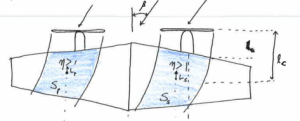I recently received a question about the effects of propeller thrust on aircraft stability and control (S&C). Within the aircraft design community, we know that power effects to S&C can be a significant engineering effort. Often, the quantification of these effects requires a powered wind tunnel test with a commensurate pricetag. With in the pilot community, we know that power -and especially propwash- significantly impacts (pun intended) the tail’s aerodynamic control power. There are jet aircraft (ex. YC-14, AV-8) using jet exhaust to provide lift and other reactions.
One interesting historical case of a power induced dihedral is the Martin 2-0-2 prototype from the late 1940s. First, let’s discuss the theory. For a twin engine propeller aircraft, the natural design configuration is mounting the engines on nacelles mid-span and in front of the wing.

We also know that the propwash has a higher dynamic pressure resulting from the increased flow velocity. The propwash during a sideslip is thus non-symmetric across the wing panels (i.e. more outboard on the downwind panel and more inboard on the upwind panel). The asymmetric flow pattern will induce a roll moment into the sideslip. We call this an anhedral effect (i.e. a positive C_L_beta), which is usually detrimental to the aircraft’s flight dynamics.
In the Martin 2-0-2 design, the prototype encountered S&C problems during flight tests. The solution was to considerably increase dihedral in the outer wing panels. This wing joint would later become a fatigue problem (https://aviation-safety.net/database/record.php?id=19480829-0&lang=en) corrected with the 2-0-2A. Overall the aircraft was not known as a success.

By Bill Larkins – Martin 2-0-2, CC BY-SA 2.0
A derivation of power induced dihedral is shown below. Notice that the magnitude depends on the angle of attack; the effect is worst at low speeds with high power settings.

